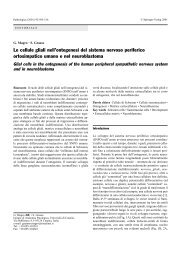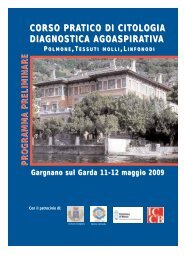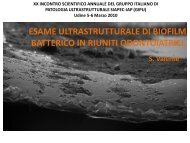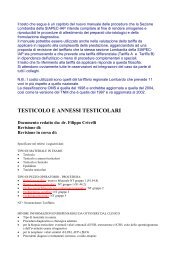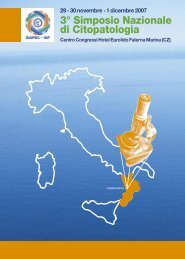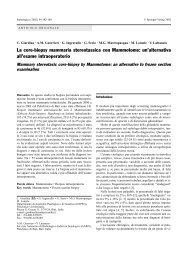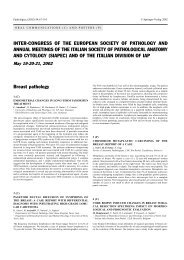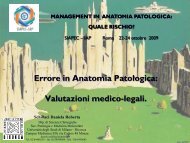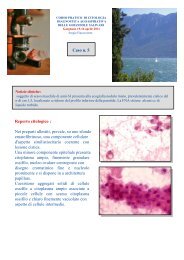pag. 216-318 - Siapec
pag. 216-318 - Siapec
pag. 216-318 - Siapec
Create successful ePaper yourself
Turn your PDF publications into a flip-book with our unique Google optimized e-Paper software.
248<br />
COMUNICAZIONI E POSTER<br />
Tab. I. Prevalenza di lesioni esofagee e/o gastriche in pazienti con MIG ed in controlli.<br />
Lesioni associate Prevalenza in casi con MIG Prevalenza in casi senza MIG p<br />
Lesioni esofagee 46,1% (42/91) 34,8% (137/394) 0,053<br />
Lesioni gastriche 13,2% (12/91) 17,2% (68/394) 0,93<br />
Lesioni esofagee + gastriche 36,3% (33/91) 23,9% (94/394) 0,017<br />
Esofago e stomaco normali 4,4% (4/91) 24,1% (95/394) < 0,0001<br />
APC promoter methylation and 5q21<br />
deletions are peculiar to gastric and<br />
duodenal endocrine tumours<br />
S. Pizzi, C. Azzoni, L. Bottarelli, T. D’Adda, C. Pasquali<br />
* , G. Rindi, C. Bordi<br />
Dipartimento di Patologia e Medicina di Laboratorio, Sezione<br />
Anatomia Patologica, Università di Parma, Parma, Italia;<br />
*<br />
Dipartimento di Scienze Mediche e Chirurgiche, Semeiotica<br />
Chirurgica, Università di Padova, Padova, Italia<br />
Background<br />
The role of the Wnt pathway in the pathogenesis of digestive<br />
endocrine tumors is still under debate. Mutations of β-catenin<br />
and E-cadherin have been found in gastrointestinal carcinoids,<br />
but not in pancreatic endocrine tumours (PETs), and generally<br />
very rare APC (adenomatous poliposis coli) mutations have<br />
been detected. The aim of the present work was to systematically<br />
investigate alterations (deletion and/or promoter methylation)<br />
of the APC locus in a series of gastroenteropancreatic endocrine<br />
neoplasms, with special emphasis to the site of origin,<br />
the level of differentiation and the clinical behaviour.<br />
Methods<br />
Sixty cases were analyzed including 38 foregut (stomach,<br />
n = 24; pancreas, n = 10; duodenum, n = 4), 14 midgut<br />
(ileum-caecum, n = 8; appendix, n = 6) and 8 hindgut<br />
(large bowel, n = 4; rectum, n = 4) tumours. According to<br />
the WHO classification, the neoplasms were further subdivided<br />
in three categories: poorly differentiated endocrine<br />
carcinomas (PDECs, n = 11), well differentiated endocrine<br />
carcinomas (WDECs, n = 27) and well differentiated endocrine<br />
tumours (WDETs, n = 22). Deletions at APC locus<br />
at 5q21 were detected by loss of heterozygosity (LOH)<br />
analysis using the microsatellite marker D5S346. The<br />
methylation status of APC promoter was analyzed by<br />
methylation-specific PCR.<br />
Results<br />
APC promoter methylation was found in 30% of cases and<br />
was restricted to foregut tumours (58%, P < 0.0001), independently<br />
of the behaviour or the differentiation. Among<br />
foregut neoplasms methylation was striking more frequent<br />
in the stomach and duodenum (75%) than in pancreas<br />
(11%, P < 0.01). LOH at APC locus was found in 37% of<br />
cases, in particular in tumours from the stomach (36%),<br />
duodenum (50%), colon (100%) and rectum (25%), but was<br />
absent in pancreas, ileum and appendix. Indeed, 5q21 LOH<br />
was more frequently detected in PDECs, from both the<br />
stomach (83% of cases) and the colon (100% of cases) than<br />
in well differentiated neoplasms, either benign or malignant<br />
(P < 0.01).<br />
Conclusions<br />
Inactivation of the Wnt pathway has previously been shown<br />
to represent a frequent and early event in gastrointestinal, but<br />
not in pancreatic, endocrine neoplasms, on the basis of immunohistochemical<br />
and mutational studies on β-catenin. Our<br />
data are in agreement with this observation and indicate APC<br />
methylation as a major mechanism for Wnt pathway inactivation<br />
in gastric and duodenal endocrine tumours.<br />
Differential involvement of the p16-Rb<br />
pathway and alterations of the CDKN2 locus<br />
in gastroenteropancreatic endocrine<br />
tumours<br />
S. Pizzi, C. Azzoni, L. Bottarelli, N. Campanini, T. D’Adda,<br />
G. Rindi, C. Bordi<br />
Dipartimento di Patologia e Medicina di Laboratorio, Sezione<br />
Anatomia Patologica, Università di Parma, Parma, Italia<br />
Background<br />
Alterations of the p16-Rb pathway appear to be implicated in<br />
the pathogenesis of gastroenteropancreatic (GEP) endocrine<br />
tumours. Previous data from our laboratory indicate that loss<br />
of p16 and/or Rb expression are frequent events in gastrointestinal<br />
endocrine carcinomas, either well (WDECs) or poorly<br />
differentiated (PDECs) 1 . The aim of the present work is to<br />
further analyze the expression of p16, Rb and cyclinD1 and<br />
the related alterations at the 9p21 CDKN2 locus (harbouring<br />
the p16, p15 and p14 genes) in different subtypes of GEP endocrine<br />
tumours, subdivided according to the site of origin,<br />
the biological behaviour and the level of differentiation.<br />
Methods<br />
Sixty cases were analyzed including 38 foregut (stomach, n<br />
= 24; pancreas, n = 10; duodenum, n = 4), 14 midgut (ileumcaecum,<br />
n = 8; appendix, n = 6) and 8 hindgut (large bowel,<br />
n = 4; rectum, n = 4) tumours. According to the WHO classification,<br />
neoplasms were further subdivided in 11 PDECs, 27<br />
WDECs and 22 well differentiated endocrine tumours<br />
(WDETs). The p16, Rb, cyclinD1 proteins were analyzed by<br />
immunohistochemisty (IHC). Deletions at CDKN2 locus<br />
were detected by loss of heterozygosity (LOH) analysis using<br />
two 9p21 microsatellite markers (D9S157, D9S171). The<br />
promoter status of p16, p15 and p14 genes was analyzed by<br />
methylation-specific PCR.<br />
Results<br />
Loss of p16 and Rb expression and hyperexpression of cyclinD1<br />
were found in 37%, 58% and 53% of cases, respectively.<br />
Significant differences were found between PDECs<br />
(characterized by absence of both p16 loss and cyclinD1 accumulation)<br />
and well differentiated neoplasms (P < 0.01).<br />
Moreover among well differentiated tumours, the pattern of<br />
expression of the three proteins varied according to the sites<br />
of origin. LOH at 9p21 was frequently (> 75% of cases)<br />
found only in PDECs and in well differentiated gastric neoplasms,<br />
either WDETs or WDECs. Promoter methylation at





